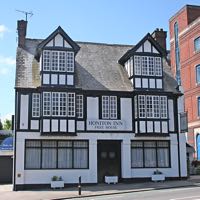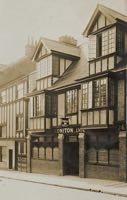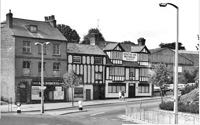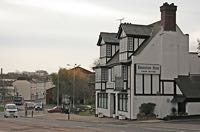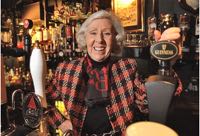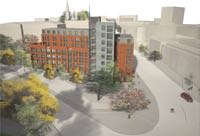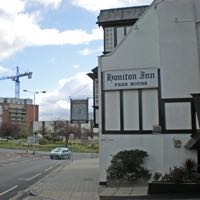
Honiton Inn – Paris Street
Page updated 22nd January 2017
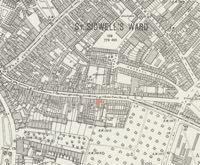 Situated
at number 74
Paris Street, this is the
only building left in the street after the bombing of 1942 and the
1950's rebuilding. This pub looks like the
house in the story that started in the country and eventually found
itself surrounded by huge office buildings in the heart of the city.
There was a large house here in 1738 with
a thatched roof. The earliest reference to the Honiton Inn I have
discovered is a notice in Trewman's Exeter Flying Post during 1795 for
a sale of the Honiton Inn which indicates
Mr Stockham as the vendor. The inn was the venue for the sale of two
small orchards, one in Cheeke Street and one in Spillars Lane during
May 1817.
Situated
at number 74
Paris Street, this is the
only building left in the street after the bombing of 1942 and the
1950's rebuilding. This pub looks like the
house in the story that started in the country and eventually found
itself surrounded by huge office buildings in the heart of the city.
There was a large house here in 1738 with
a thatched roof. The earliest reference to the Honiton Inn I have
discovered is a notice in Trewman's Exeter Flying Post during 1795 for
a sale of the Honiton Inn which indicates
Mr Stockham as the vendor. The inn was the venue for the sale of two
small orchards, one in Cheeke Street and one in Spillars Lane during
May 1817.
It would appear from records, that the job of inn keeper led to
many a
suicide. In the Flying Post of 10 January 1825, the inquest into the
suicide of John Franklin, of
the Honiton Inn is reported, and a month later the inn was for sale by
auction. The next landlord, Mr John Hawkins was found not guilty of out
of hours trading in December 1848. A sale for a thoroughbred horse
called Atlantic at the Honiton Inn was advertised over two months in
1852 with Husseys conducting the affair. Mr Hawkins gave way for Mr
Henry Stevens in 1853 who remained until he was declared bankrupt in
1859. He was charged damages in August 1857 for shooting a dog
belonging to Mr Floud. During all these years the inn was regularly
used for inquests into the deaths of locals from Paris Street.
In June 1872 the owner for many years, Mr John Wippel died and the inn was put up for sale.
"Dwelling and Shop adjoining the Inn, having a frontage of 59 feet and a depth of 179 feet, containing bar, smoking room, tap room, kitchen, and excellent bed and sitting rooms. There is a commodious cellar, a brewhouse, four-stall stable, a good skittle alley, and a well of excellent spring water. The adjoining dwelling contains shop, with sitting room behind, and three bed rooms. This lot is occupied by Mr. Higgins and Mr Leyman."
In 1889, the landlord, Mr Morgan umpired a 'married and singles' rounders match. The next encumbent, Mr Welsman, appears to have encouraged the playing of bagatelle in the house, and was also involved in the Rovers Cycling Club when he provided refreshments at various functions for their members.
Paris Street was formerly called Shitbrook Street as it ran down to the Shitbrook, presumably at the roundabout. The present building is Mock Tudor, and dates from the early 20th Century.
The black market store
From 1936, the house was run by Marjorie and 'Percy' Bradford. During the blitz, Percy kept the pub open 24 hours a day, serving the rescue services with food and drink. One memory of the time claims that the landlord kept a cache of supplies hidden in the stables, to which the police turned a blind eye, as they had also taken advantage of these 'extra' victuals. Some of these supplies were even sent to the Duke of York in Sidwell Street, to supplement their stock. Ernest Woolacott who was in charge of the Danes Castle reservoir, toured the city to ensure that the mains pressure was sufficient for the many hoses being used at the time. He stayed at the Honiton Inn to rest, and his presence was useful to keep the water supply on line.
The pub was also popular with US Marines who were in the city waiting for D-day. The stores at the rear included black market nylons and other goods not easily available in the shops.
After the war, Major Frank Robertson took on the license which he held until his death in 1974. His widow Bette purchased the pub from the brewery, in the same year as her husband died, and continued to run the house until her own death in 2008. An auction of the contents, including an aeroplane propeller that hung fro the ceiling, took place in 2008.
The house remained empty, often with 'for sale' notices outside until September 2016, when Grainge Architects, a local architectural practice submitted plans to demolish the building, and replace it with luxury student accommodation.
Here are some entries from the
trade directories, listing some past
tenants of the Honiton Inn:
1795 - Honiton Inn,
Mr Stockman, vendor - for sale notice Flying Post
1816 - Franklin. J., honiton inn p.h. paris s - Pocket Journal
1825 - Honiton Inn, John Franklin - Flying Post
1832/3 - Honiton Inn, John Franklin, Paris street - Pigot's
1844 - Honiton inn, John Mount Stephen, Paris st - Pigot's
1871 - Higgins, C., honiton inn, 74, paris-street - Pocket Journal
1878 - Honiton Inn, Charles Higgins - White's
1897 - Honiton inn, Charles Morgan - Kelly's
1919-23 - Honiton Inn, Mrs Florence Chaplin - Kelly's and Post Office
1934 - Honiton, Wayne, H., 74, Paris st - Besley's
1936 to 1948 -
Honiton Inn, Percival Bradford - E&E 2008
1948 to 2008 - Honiton Inn, Frank W and Bette Robertson - Kelly's
Sources: British Newspaper Archive, Express and Echo and memories of Pete Braven-Giles.
│ Top of Page │
